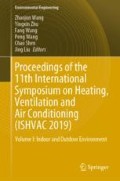Abstract
A cross-sectional study data about building dampness indicators and perceptions of undesirable odors and child’s asthma and allergy symptoms were collected by means of a questionnaire in the urban area of Harbin, China. A total of 2600 families with children 2–8 years old returned completed and effective surveys. The most frequently self-reported symptom was sneezing without cold or flu (41.8%); condensation on windowpanes (43.9%) was indication of high relative humidity indoor air combined with cold surfaces; residents were more unsatisfied with the smell in the air during the last three months than the newborn period. Perceived dampness was the important risk factor for children’s health outcomes during lifetime-ever and during the last 12 months. Most of the dampness indicators and perceptions of odors were significantly associated with child’s asthma and allergy symptoms. Indoor dampness indicators were risk factor for the rhinitis and sneezing without cold; similar results were found in the undesirable odors analyses, and they were risk factors for the rhinitis, wheezing, allergy, and eczema. In spring and summer, the occasional ventilation had certain inhibitory effect on the asthma, but in spring, frequent ventilation was a risk factor for asthma. Ventilation is an effective method for removing or diluting indoor potentially harmful pollutants.
Access this chapter
Tax calculation will be finalised at checkout
Purchases are for personal use only
References
Zhang, Y., Li, B., Huang, C., et al.: Ten cities cross-sectional questionnaire survey of children asthma and other allergies in China. Chin. Sci. Bull. 58, 4182–4189 (2013)
Fan, G., Xie, J., Yoshino, H., et al.: Environmental conditions in homes with healthy and unhealthy schoolchildren in Beijing. China. Build. Environ. 112, 270–284 (2017)
Bornehag, C.G., Sundell, J., Hagerhed-Engman, L., et al.: “Dampness” at home and its association with airway, nose and skin symptoms among 10,851 preschool children in Sweden: a cross-sectional study. Indoor Air 15, 48–55 (2005)
Clausen, G., Høst, A., Toftum, J., et al.: Child’s health and its association with indoor environments in Danish homes and daycare centre-methods. Indoor Air 22, 467–475 (2012)
Bu, Z., Wang, L., Weschler, L.B., et al.: Associations between perceptions of odors and dryness and child’s asthma and allergies: a cross-sectional study of home environment in Baotou. Build. Environ. 106, 167–174 (2016)
Wang, H., Li, B., Yu, W., et al.: Early-life exposure to home dampness associated with health effects among children in Chongqing. China. Build. Environ. 94, 327–334 (2015)
Liu, W., Huang, C., Hu, Y., et al.: Associations of building characteristics and lifestyle behaviors with home dampness-related exposures in Shanghai dwellings. Build. Environ. 88, 106–115 (2015)
Wang, L., Qu, F., Zhang, Y., et al.: Home environment in relation to allergic rhinitis among preschool children in Beijing, China: a cross-sectional study. Build. Environ. 93, 54–63 (2015)
Larsson, M., HägerhedEngman, L., Moniruzzaman, S., et al.: Can we trust cross-sectional studies when studying the risk of moisture-related problems indoor for asthma in children? Int. J. Environ. Health Res. 21(4), 237–247 (2011)
Acknowledgements
The project is supported by the National Key Research and Development Program of China (Grant No. 2016YFC0207103).
Informed consent Informed consent was obtained from all individual participants included in the study. All data are anonymous and do not reveal information about any households.
Author information
Authors and Affiliations
Corresponding author
Editor information
Editors and Affiliations
Rights and permissions
Copyright information
© 2020 Springer Nature Singapore Pte Ltd.
About this paper
Cite this paper
Bu, S., Wang, Y., Wang, F., Wang, H., Tan, Y. (2020). Childhood Asthma and Allergic Symptoms Associated with Residential Dampness and Undesirable Odors. In: Wang, Z., Zhu, Y., Wang, F., Wang, P., Shen, C., Liu, J. (eds) Proceedings of the 11th International Symposium on Heating, Ventilation and Air Conditioning (ISHVAC 2019). ISHVAC 2019. Environmental Science and Engineering(). Springer, Singapore. https://doi.org/10.1007/978-981-13-9520-8_149
Download citation
DOI: https://doi.org/10.1007/978-981-13-9520-8_149
Published:
Publisher Name: Springer, Singapore
Print ISBN: 978-981-13-9519-2
Online ISBN: 978-981-13-9520-8
eBook Packages: Earth and Environmental ScienceEarth and Environmental Science (R0)

